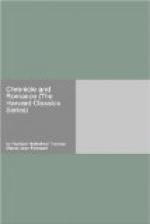this rude kind of building made the Spaniards in Queen
Mary’s days to wonder, but chiefly when they
saw what large diet was used in many of these so homely
cottages; insomuch that one of no small reputation
amongst them said after this manner—“These
English (quoth he) have their houses made of sticks
and dirt, but they fare commonly so well as the king.”
Whereby it appeareth that he liked better of our good
fare in such coarse cabins than of their own thin
diet in their prince-like habitations and palaces.
In like sort as every country house is thus apparelled
on the outside, so is it inwardly divided into sundry
rooms above and beneath; and, where plenty of wood
is, they cover them with tiles, otherwise with straw,
sedge, or reed, except some quarry of slate be near
hand, from whence they have for their money much as
may suffice them. The clay wherewith our houses
are impannelled is either white, red, or blue; and
of these the first doth participate very much of the
nature of our chalk; the second is called loam; but
the third eftsoons changeth colour as soon as it is
wrought, notwithstanding that it looks blue when it
is thrown out of the pit. Of chalk also we have
our excellent asbestos or white lime, made in most
places, wherewith being quenched, we strike over our
clay works and stone walls, in cities, good towns,
rich farmers’ and gentlemen’s houses:
otherwise, instead of chalk (where it wanteth, for
it is so scant that in some places it is sold by the
pound), they are compelled to burn a certain kind
of red stone, as in Wales, and elsewhere other stones
and shells of oysters and like fish found upon the
sea coast, which, being converted into lime, doth naturally
(as the other) abhor and eschew water, whereby it
is dissolved, and nevertheless desire oil, wherewith
it is easily mixed, as I have seen by experience.
Within their doors also, such as are of ability do
oft make their floors and parget of fine alabaster
burned, which they call plaster of Paris, whereof
in some places we have great plenty, and that very
profitable against the rage of fire. In plastering
likewise of our fairest houses over our heads, we use
to lay first a line or two of white mortar, tempered
with hair, upon laths, which are nailed one by another
(or sometimes upon reed of wickers more dangerous
for fire, and make fast here and there saplaths for
falling down), and finally cover all with the aforesaid
plaster, which, beside the delectable whiteness of
the stuff itself, is laid on so even and smoothly
as nothing in my judgment can be done with more exactness.
The walls of our houses on the inner sides in like
sort be either hanged with tapestry, arras work, or
painted cloths, wherein either divers histories, or
herbs, beasts, knots, and such like are stained, or
else they are ceiled with oak of our own, or wainscot
brought hither out of the east countries, whereby the
rooms are not a little commended, made warm, and much
more close than otherwise they would be. As for
stoves, we have not hitherto used them greatly, yet
do they now begin to be made in divers houses of the
gentry and wealthy citizens, who build them not to
work and feed in, as in Germany and elsewhere, but
now and then to sweat in, as occasion and need shall
require it.




